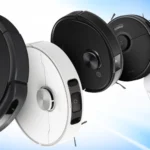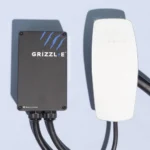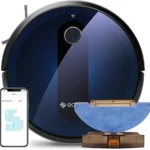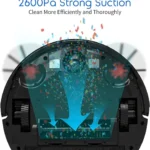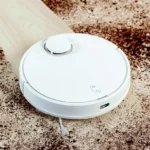When it comes to charging a smart vacuum cleaner, many homeowners are unaware of the potential risks involved. While it may seem like a simple task, improper charging can result in serious safety hazards. It’s crucial to take safety measures when charging your vacuum cleaner. In this article, we’ll explore the top safety measures you need to consider to prevent accidents and prolong the lifespan of your smart vacuum cleaner. Whether it’s avoiding third-party chargers, keeping the charging area clear of obstructions, or avoiding charging near water sources, we’ll cover it all. So, let’s dive in and learn how to charge your smart vacuum cleaner safely.
Why is it important to take safety measures while charging a smart vacuum cleaner?
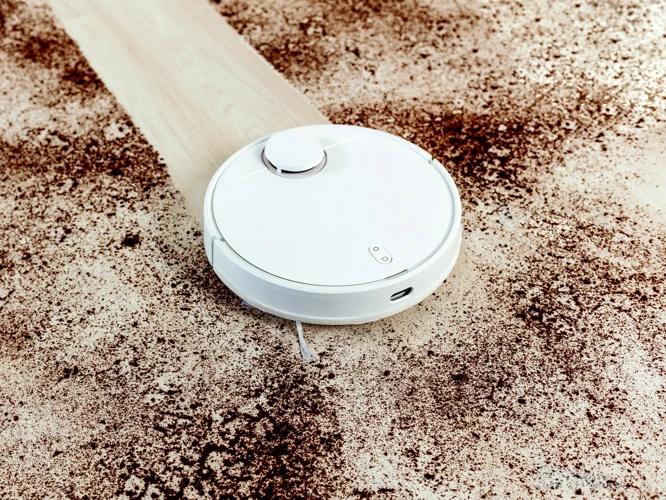
Charging a smart vacuum cleaner is an essential task to keep your appliance running effectively. However, it’s crucial to take safety measures while charging a smart vacuum cleaner to avoid any danger or damages. It’s vital to understand why it is essential to perform this task with utmost caution.
One of the primary reasons why it’s important to take safety measures while charging a smart vacuum cleaner is to ensure the safety of your home and everyone in it. Overheating or short-circuiting can result in fire accidents or explosions, which can cause significant damage to your house and put everyone’s life at great risk. This is especially important to keep in mind if you have children or pets in your home.
Another reason why safety measures are vital is to prevent any damage to your smart vacuum cleaner, which can happen if you use a defective charger or charge the appliance in extreme temperatures. Using third-party chargers can cause damage to the battery and render it inoperable. Charging a vacuum cleaner in extreme temperatures can damage the battery and reduce its life.
Taking safety measures while charging your smart vacuum cleaner should also be a priority to ensure optimal performance of your appliance for longer. Overcharging or charging a vacuum cleaner with a damaged battery can affect its performance and reduce its battery life. This can significantly affect your cleaning tasks and cause inconvenience.
Following the right charging cycle, using a recommended charger, keeping the battery cool, and avoiding overcharging are some of the critical factors to keep in mind while charging a smart vacuum cleaner. Reading the manufacturer’s manual and following their instructions can help you ensure that you are doing everything correctly while charging your smart vacuum cleaner.
It is essential to take safety measures while charging a smart vacuum cleaner to avoid any accidents, prevent damage to your appliance, and ensure its optimal performance. With proper care and attention, you can extend your smart vacuum cleaner’s battery life and guarantee that it runs smoothly for years to come. Remember to follow the manufacturer’s manual and take precautions to ensure that charging your appliance is a success.
1. Avoid using third-party chargers
When it comes to charging your smart vacuum cleaner, it’s crucial to take every precaution necessary. One of the most important safety measures is to avoid using third-party chargers. While third-party charging options may seem like a bargain, they can pose serious risks to both you and your vacuum cleaner. In this section, we’ll explore why it’s essential to stick to the manufacturer’s recommended charger and how using a third-party charger could lead to issues such as smart vacuum not charging, charging issues, and even shortened battery life. We’ll also provide you with some tips to ensure you get the most out of your smart vacuum cleaner’s charging cycle.
2. Keep the charging area clear of obstructions
When charging your smart vacuum cleaner, it is important to keep the charging area clear of obstructions. This will ensure that the vacuum cleaner receives proper ventilation and does not overheat during the charging process.
Why is it important to keep the charging area clear of obstructions?
When you place your smart vacuum cleaner on the charging dock, it starts the charging cycle. The charging cycle can generate heat, and if the area around the vacuum cleaner is cluttered, it can restrict airflow and cause heat to build up inside the charging dock. This can lead to overheating, which can damage the battery and other components of the vacuum cleaner.
What should you do to keep the charging area clear of obstructions?
To prevent obstructions from impeding airflow and causing overheating, follow these tips for keeping the charging area clear:
| Tip | Description |
|---|---|
| Remove any objects from the charging dock | Before placing your vacuum cleaner on the charging dock, make sure you remove any items that may be in the way. This could include small objects such as toys or larger items such as furniture. |
| Keep the charging dock in an open area | Place the charging dock in an open area that is free from clutter or obstruction. Doing so will ensure proper ventilation and prevent overheating during the charging cycle. |
| Avoid placing the vacuum cleaner on soft surfaces | When placing your vacuum cleaner on the charging dock, make sure it is on a hard, level surface. Avoid placing it on soft surfaces such as carpets, as this can impede airflow and cause overheating. |
By following these tips, you can help prevent potential damage to your smart vacuum cleaner and ensure that it charges safely and efficiently. In case you want to learn more about impact of room temperature on smart vacuum charging or what to do in case of using defective charger, feel free to check our articles on ‘Smart Vacuum Charging Cycle‘ and ‘Defective Charger vs Smart Vacuum Issue‘.
3. Avoid charging near water sources
One of the top safety measures to keep in mind while charging a smart vacuum cleaner is to avoid charging near water sources. This is because water can conduct electricity, which can lead to a short circuit and damage the vacuum cleaner’s battery.
Here are some tips to help you avoid charging near water sources:
- Do not charge your vacuum cleaner near a sink, bathtub, or shower.
- Keep the charging station away from damp or wet areas, such as a laundry room or a bathroom.
- Avoid charging your smart vacuum cleaner on a wet surface or near standing water.
- Make sure your hands are dry before plugging or unplugging the vacuum cleaner charger.
It is essential to take these precautions to prevent any accidents that can harm both yourself and your smart vacuum cleaner. Even a small amount of water can cause a short circuit, so it is crucial to keep the charging area dry.
Charging your vacuum cleaner near water sources can also impact the room temperature, which can affect the vacuum cleaner’s charging capacity. To learn more about how temperature can impact smart vacuum cleaners while charging, please refer to our informative article on the impact of room temperature on smart vacuum charging.
It is always better to be safe than sorry when it comes to handling electrical appliances, especially when they are charging. A little bit of caution can go a long way, and following these tips can help ensure that you charge your smart vacuum cleaner safely and protect it from damage.
4. Never charge the vacuum cleaner outdoors
Smart vacuum cleaners have become a popular choice for many households, thanks to their efficiency and convenience. However, it’s essential to take safety measures when charging them to avoid any accidents. One crucial safety measure is to never charge the vacuum cleaner outdoors.
Why is it unsafe to charge a vacuum cleaner outdoors?
Charging a vacuum cleaner outdoors can endanger both the vacuum cleaner and individuals’ safety. Outdoor charging exposes the vacuum cleaner to various environmental factors such as moisture, dirt, and extreme temperatures that can damage the device or cause malfunctions. Additionally, charging electrical devices outdoors can pose a risk of electric shock and increase the chances of a fire due to exposure to water, overheating, or short circuits.
What are the risks of charging a vacuum cleaner outdoors?
Charging a vacuum cleaner outdoors puts it at risk of several hazards. Here are some of the risks associated with outdoor charging:
- Exposure to moisture: Charging a vacuum cleaner outdoors can expose it to moisture, which can damage the device and cause electric shock.
- Overheating: Vacuum cleaners generate heat during charging, and exposure to direct sunlight or high temperatures can cause overheating, leading to damage or fire hazards.
- Dust and dirt: Outdoor charging exposes the vacuum cleaner to dust and dirt, which can accumulate on the device and affect its performance, causing malfunctions or breakdowns.
- Falling: Placing the vacuum cleaner on the ground or a surface during outdoor charging increases the risk of it falling, which can damage its components.
Where should you charge your vacuum cleaner?
It’s always best to charge your smart vacuum cleaner in a cool, dry, and well-ventilated area. This will minimize the risk of damage to the device and maintain its safety during charging. A dedicated charging area is an ideal place to charge your vacuum cleaner as it provides a stable surface, and it’s away from any potential hazards.
Charging a vacuum cleaner outdoors is a safety hazard and can damage the device, cause electric shock, and start fires. It’s crucial to follow safety measures and charge your smart vacuum cleaner indoors in a cool, dry, and well-ventilated place away from any obstructions and water sources to ensure its longevity and safety.
5. Keep your vacuum cleaner away from heat sources
Smart vacuum cleaners are designed with advanced features to make cleaning an easy and efficient process. However, it is crucial to ensure that you handle your device with the utmost care to avoid accidents. One important safety measure to take while charging your smart vacuum cleaner is to keep it away from heat sources.
Why is it important to keep your vacuum cleaner away from heat sources?
Heat sources can be a potential fire hazard when they come into contact with your vacuum cleaner while charging. High temperatures can lead to damage to the battery, which can cause it to overheat and potentially catch fire. This could result in serious injury, property damage, and even death in extreme cases. It is essential to keep your vacuum cleaner away from heat sources.
What are the examples of heat sources to avoid?
Here is a list of heat sources to avoid when charging your vacuum cleaner:
- Direct sunlight
- Ovens or stoves
- Fireplaces or heaters
- Electrical devices that generate heat, such as refrigerators and freezers
- Any other high-temperature areas within your home
What are the tips to follow to keep your vacuum cleaner safe?
To keep your smart vacuum cleaner safe while charging, here are some tips to follow:
- Always keep your vacuum cleaner in an open and well-ventilated area while charging.
- Avoid charging your vacuum cleaner near any heat sources or flammable materials.
- Make sure to unplug your vacuum cleaner after charging and store it in a cool, dry place.
- Regularly check the battery for any signs of damage or overheating.
- If you notice any abnormal smells or sounds coming from your vacuum cleaner while charging, immediately disconnect it from the power source and seek professional help.
By following these safety measures, you can ensure that your smart vacuum cleaner is protected while charging, and you can enjoy a safe and efficient cleaning experience.
How to charge your smart vacuum cleaner safely?
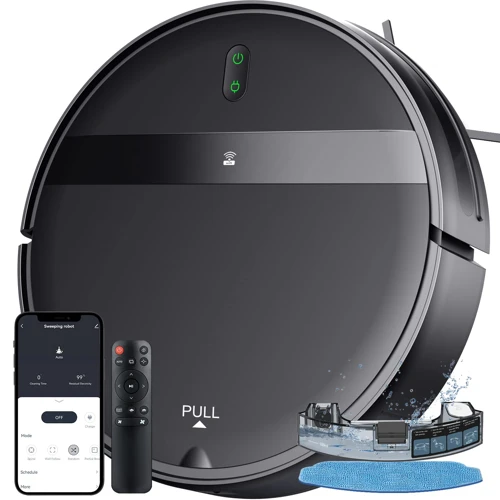
To ensure that your smart vacuum cleaner stays in good shape, it’s important to charge it safely. Here are some steps to follow:
6. Read the manufacturer’s manual
The first step to safely charging your smart vacuum cleaner is to read the manufacturer’s manual. This will give you important insights into the specific charging requirements for your device. Make sure to carefully read any warnings or cautions related to charging and follow them.
7. Don’t overcharge your vacuum cleaner
Overcharging your vacuum cleaner can cause severe damage to the battery and, in some cases, even lead to a fire. To avoid this, make sure to unplug your vacuum cleaner once it’s fully charged. Some smart vacuum cleaners have a feature that automatically stops charging once the battery is full, so check if your device has this.
8. Always unplug the vacuum cleaner after charging
Leaving your vacuum cleaner plugged in for an extended period of time can increase the risk of damage to the battery. To prevent this, make sure to unplug your vacuum cleaner as soon as it’s done charging. This is especially important if you’re planning on leaving your home or going to bed.
9. Make sure the battery is cool before charging
Charging a hot battery can cause damage and reduce its lifespan. Before plugging in your vacuum cleaner to charge, make sure to wait until the battery has cooled down. This is especially important if you’ve just finished using the vacuum cleaner.
10. Do not charge in extreme temperatures
Charging your smart vacuum cleaner in extreme temperatures can also cause damage to the battery. Avoid charging it in areas with high humidity, direct sunlight, or extreme temperatures. Opt for a cool and dry place instead.
11. Keep the vacuum cleaner away from children and pets while charging
Children and pets can be curious and may accidentally knock over your vacuum cleaner or play with the charging cord when you’re not around. Make sure to keep your vacuum cleaner and its charging cord out of their reach, and always supervise them when they’re around it.
By following these simple steps, you can ensure that your smart vacuum cleaner remains in good condition and is always ready to serve you.
6. Read the manufacturer’s manual
Before charging your smart vacuum cleaner, it is crucial to familiarize yourself with the manufacturer’s manual. This document contains essential instructions on how to safely charge your device and prevent any potential hazards. Neglecting to read the manual may result in damaging the battery or even causing a fire. Take the time to carefully review the manual and understand its recommendations to ensure the longevity and safe operation of your vacuum cleaner.
7. Don’t overcharge your vacuum cleaner
It is crucial not to overcharge your smart vacuum cleaner, as it can not only shorten the battery life but also pose serious safety risks. Overcharging can cause the battery to overheat, swell, or even explode, which can lead to property damage, injuries, or even fatalities. It is essential to follow the manufacturer’s guidelines regarding the recommended charging time and avoid leaving the vacuum cleaner plugged in longer than necessary.
Here are some tips to avoid overcharging your smart vacuum cleaner:
- Read the manufacturer’s manual: Before using and charging your smart vacuum cleaner, make sure to read the manual carefully as it contains valuable information about the battery type, charging time, and other essential details.
- Use the recommended charger: Always use the charger provided by the manufacturer or a compatible one to ensure proper voltage and current output. Using a third-party or inappropriate charger can damage the battery and increase the risk of overcharging.
- Set a timer: If your smart vacuum cleaner does not have an automatic shut-off feature, you can use a timer or alarm clock to remind you when the charging time is over. Most smart vacuum cleaners require between 2 to 4 hours to fully charge, depending on the battery capacity and type.
- Check the battery level: Some smart vacuum cleaners come with a battery indicator that shows the current charge level. Before plugging in the charger, check the battery level to see how much charge it needs. Avoid charging the battery from 100% to 0% or vice versa, as it can reduce its lifespan.
- Monitor the charging process: While the vacuum cleaner is charging, keep an eye on it to see if it overheats, emits strange smells or sounds, or shows other signs of malfunction. If you notice any abnormalities, unplug the charger and contact the manufacturer for assistance.
Remember that proper care and maintenance of your smart vacuum cleaner’s battery can ensure long-lasting performance and safe operation.
8. Always unplug the vacuum cleaner after charging
After you have followed all the necessary steps to safely charge your smart vacuum cleaner, one important measure to remember is to always unplug the vacuum cleaner after charging. This is crucial as leaving your vacuum cleaner plugged in can lead to potential hazards or damage to the battery.
Leaving the vacuum cleaner plugged in can lead to overcharging, which can cause damage to the battery and even result in a fire hazard. If there is a power surge or lightning strike, this can also cause damage to the vacuum cleaner or the battery due to an electrical surge.
To prevent such dangerous situations, make it a habit to unplug the vacuum cleaner once it is fully charged. This is also beneficial for the longevity of the battery, as overcharging or leaving it plugged in for long periods can shorten its life.
To make it easier to remember, you can create a checklist and tick off each step once completed. Here’s an example:
| Step | Action |
| Step 1 | Connect the vacuum cleaner to the charging station |
| Step 2 | Wait until the battery is fully charged |
| Step 3 | Unplug the charger from the socket |
| Step 4 | Disconnect the vacuum cleaner from the charging station |
| Step 5 | Store the vacuum cleaner in a safe place |
By creating a simple checklist, you can ensure that all necessary steps are taken to safely charge your smart vacuum cleaner and avoid any potential hazards. Remember, always unplug your vacuum cleaner after charging to prevent any damage to the battery and prevent accidents.
9. Make sure the battery is cool before charging
Smart vacuum cleaners have become an essential tool in household cleaning, but safety should always come first. When charging these devices, it is important to take certain measures to avoid accidents. One of these measures is to make sure the battery is cool before charging.
Lithium-ion batteries are used in most smart vacuum cleaners, and they can become hot when in use. It is important to let the battery cool down before starting to charge it. This will not only prevent accidents, but it will also ensure the longevity of the battery.
To ensure a cool battery before charging, consider the following tips:
| Tips to cool down the battery before charging |
|---|
| Avoid using the vacuum cleaner for 30 minutes before charging |
| Avoid charging the vacuum cleaner near heat sources such as radiators or stoves |
| Remove the battery from the vacuum cleaner and let it cool down for 30 minutes before charging |
| Avoid charging the vacuum cleaner in direct sunlight or in hot temperatures |
| Make sure the battery is not visibly hot to the touch before charging |
By following these tips, you can ensure that the battery is cool and safe to charge. Remember to always refer to the manufacturer’s manual for specific instructions on how to charge your smart vacuum cleaner. Taking safety measures seriously can prevent accidents and extend the life of your device.
10. Do not charge in extreme temperatures
The battery of a smart vacuum cleaner is a crucial component that requires special care while charging to ensure its longevity and maximum efficiency. One of the important safety measures to keep in mind while charging a smart vacuum cleaner is to avoid extreme temperatures. Extreme temperatures can lead to permanent damage to the battery or even be hazardous.
Charging a smart vacuum cleaner in excessive heat or cold can cause the battery to overheat or become too cold. This is especially important to keep in mind during the hotter or colder months of the year. Excess heat can cause the battery to degrade, leading to a shorter lifespan and reduced performance. Similarly, charging a smart vacuum cleaner in extreme cold temperatures can reduce the battery’s capacity and make it challenging to charge. It can also cause damage to the battery and other internal components.
To help understand the optimal temperature range for charging the battery of a smart vacuum cleaner, refer to this table:
| Temperature Range | Optimal Charging Temperature | Effect on Battery |
|---|---|---|
| -4°F to 113°F (-20°C to 45°C) | 32°F to 113°F (0°C to 45°C) | Normal Charging Conditions |
| Below -4°F (-20°C) or Above 113°F (45°C) | Do not Charge | Damage to battery and performance |
Charging a smart vacuum cleaner in extreme temperatures can be detrimental to both the battery’s lifespan and safety. It is advisable to be mindful of the temperature range while charging and avoid any extreme heat or cold conditions. By taking the necessary safety measures and following the manufacturer’s instructions, you can help ensure the prolonged lifespan and maximum efficiency of your smart vacuum cleaner.
11. Keep the vacuum cleaner away from children and pets while charging
It is crucial to keep your smart vacuum cleaner away from children and pets while charging to avoid any potential accidents. Here are some tips to ensure safety in such situations:
- Place the vacuum cleaner in a secure location: Make sure the charging area is not accessible to children or pets. Choose a location that is high or out of reach, such as a shelf or a cupboard.
- Supervise your children and pets: If you are unable to store the vacuum cleaner in a secure location, make sure to supervise your children and pets while it is charging. Keep an eye on them to avoid any potential accidents.
- Warn your children and pets: Warn your children and pets about the potential danger of the vacuum cleaner while it is charging. Let them know that it is not a toy and they should not play with it.
- Unplug the charger after use: Make sure to unplug the charger after use to prevent any curiosity-driven incidents. Store the charger in a safe location away from children and pets.
- Use caution when handling the vacuum cleaner: Even when the vacuum cleaner is not charging, make sure to handle it with caution around children and pets to avoid any potential accidents.
Remember, accidents can happen in seconds, so it’s crucial to take precautions to ensure the safety of your loved ones. Keep these tips in mind to avoid any mishaps and charge your smart vacuum cleaner with confidence.
What to do in case of emergency?
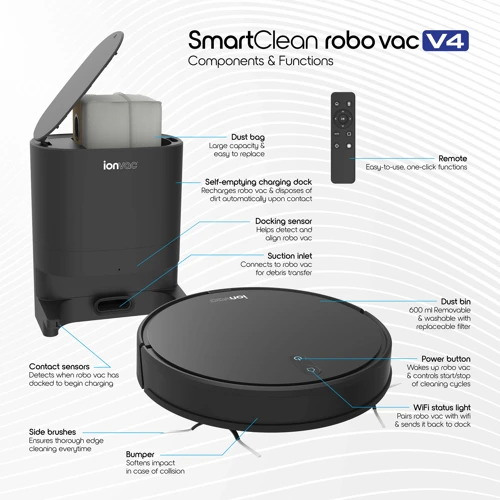
Unexpected situations and emergencies can occur at any time, and it is essential to know how to react to them. Similarly, in case of any emergency while charging your smart vacuum cleaner, you need to take prompt action to minimize any potential damage or harm. Here are some crucial steps to follow in case of emergencies:
1. Unplug and disconnect the charger immediately in case of smoke or burning odor
Burning smells and smoke emanating from your smart vacuum cleaner while charging are clear signs of something being wrong. If you notice such symptoms, you must unplug and disconnect the charger from the power source immediately. Continuing to charge the cleaner can cause severe damage to the battery, the device, and even the environment.
2. Handle the vacuum cleaner carefully if the battery is damaged
If you notice any damage to the battery or its components while charging your smart vacuum cleaner, you must handle it with extreme caution. Do not touch a damaged battery with your bare hands or expose it to water or any other liquids. Additionally, you must avoid puncturing, crushing or accessing the internal components of the battery.
3. Do not operate a vacuum cleaner with a damaged battery
Using a vacuum cleaner with a damaged battery can be extremely dangerous and risky. Such a situation can expose you to severe electric shocks that can threaten your life. As soon as you notice any damage to the battery, stop using the cleaner immediately and follow the manufacturer’s recommended steps to address the problem.
4. Seek professional help if needed
If you are unsure what to do in case of an emergency while charging your smart vacuum cleaner, it is always better to seek professional help from experts. You can reach out to the manufacturer, customer support lines, or any credible technician to guide you through the process.
By following these essential steps, you can respond promptly and adequately to any emergencies that may arise while charging your smart vacuum cleaner. Ensuring proper safety measures will not only protect the device from damage but also guarantee your well-being and security.
12. Unplug and disconnect the charger immediately in case of smoke or burning odor
It can be a terrifying experience to witness smoke or detect a burning odor while charging your smart vacuum cleaner. Your first instinct might be to panic, but it’s crucial to act calmly and quickly to prevent any potential danger. In this situation, your immediate priority should be to unplug and disconnect the charger immediately. Failure to do so can result in serious consequences, including the risk of electrical fires or damage to your vacuum cleaner. Here are some important steps to follow if you detect smoke or a burning odor while charging your smart vacuum cleaner.
13. Handle the vacuum cleaner carefully if the battery is damaged
It is important to handle a vacuum cleaner with a damaged battery carefully as it may pose a risk of fire or explosion. If you notice any signs of damage to the battery, such as swelling, leaking, or corrosion, take immediate action to ensure your safety and the safety of others.
Here are some tips to handle a vacuum cleaner with a damaged battery:
| Tips | Explanation |
|---|---|
| 1. Turn off the vacuum cleaner | As soon as you notice any damage to the battery, turn off the vacuum cleaner to prevent any electrical surges or sparks that could ignite a fire. |
| 2. Do not touch the battery | Do not attempt to remove or touch the battery as it may be hot or leaking. Contact the manufacturer for guidance on safe handling. |
| 3. Keep the vacuum cleaner away from flammable materials | If you notice any signs of damage to the battery, move the vacuum cleaner away from any flammable materials such as curtains or papers to prevent any potential ignition. |
| 4. Use protective gear | If you need to handle the vacuum cleaner with a damaged battery, make sure to wear protective gear such as gloves and eye protection to prevent any harm from battery acid or other hazards. |
| 5. Contact the manufacturer or a professional | If you are unsure of how to handle a vacuum cleaner with a damaged battery, contact the manufacturer or a professional for guidance. Do not attempt to repair or replace the battery on your own. |
Remember, safety should always be your top priority when handling a vacuum cleaner with a damaged battery. Take the necessary precautions and seek professional help when needed to prevent any accidents or injuries.
14. Do not operate a vacuum cleaner with a damaged battery
Operating a vacuum cleaner with a damaged battery can pose a serious threat to both the user and the device. If the battery is damaged, it can cause the vacuum cleaner to malfunction or even catch fire. So, it’s crucial to never operate a vacuum cleaner with a damaged battery.
Here are some signs that your vacuum cleaner’s battery might be damaged:
- Swollen battery: If you notice that the battery of your vacuum cleaner is bulging or swollen, then it is definitely damaged. A swollen battery is not safe to operate as it can lead to an explosion or fire.
- Overheating: If your vacuum cleaner battery is overheating during use or charging, then it may be damaged. Overheating can also damage the device and cause it to be dangerous to use.
- Decreased run time: If your vacuum cleaner battery is not holding a charge for as long as it used to, then it may be damaged. A damaged battery will have a decreased runtime as it may not be able to hold a charge as efficiently as before.
- Strange noises: If your vacuum cleaner is making strange noises during use or charging, then it may be a sign of a damaged battery. Strange noises can indicate that the battery is about to fail or already has.
If you notice any of these signs, then it’s crucial to stop using your vacuum cleaner immediately and get it inspected or repaired by a professional. The risk of injury or damage to property is not worth the continued use of a potentially hazardous device.
Remember, prevention is always better than cure. Take all the necessary precautions while charging your vacuum cleaner and follow the manufacturer’s guidelines to avoid any damage to your device’s battery.
15. Seek professional help if needed
If you ever encounter an issue while charging your smart vacuum cleaner, it’s always better to seek professional help than to try to fix the problem yourself. Attempting to solve the problem on your own might cause further damage or even lead to injuries. Seek help from a qualified technician if you notice anything unusual, such as smoke or a burning odor.
Here are some signs that indicate you should seek professional help:
- Smoke or burning odor: If you notice smoke or a burning smell emanating from your vacuum cleaner while charging, immediately unplug and disconnect the charger. This is a serious issue that must be addressed by a technician.
- Physical damage: If you notice any physical damage to the vacuum cleaner’s battery or charger, such as cracks, dents, or exposed wires, do not attempt to use or repair the device on your own. Contact a qualified technician for assistance.
- Erratic behavior: If your vacuum cleaner is behaving erratically, such as overcharging or undercharging the battery, or if the vacuum cleaner stops working mid-cycle, seek professional help. This could be a sign of a malfunctioning battery or charger.
Remember, safety should be your top priority when dealing with electronic devices. It’s always better to err on the side of caution and seek professional help if you are unsure about any aspect of charging your vacuum cleaner.
Tips to extend your vacuum cleaner’s battery life
If you own a smart vacuum cleaner, then you have probably experienced the frustration of running out of battery in the middle of cleaning. Here are some helpful tips to extend the battery life of your vacuum cleaner and ensure you get the most out of your device.
1. Store the vacuum cleaner in a cool, dry place
When not in use, make sure to store your vacuum cleaner in a cool, dry place. Avoid exposing the device to direct sunlight, as this can cause the battery to overheat and shorten its lifespan. Additionally, high humidity can cause damage to the battery, so it’s important to keep it in a dry environment.
2. Keep the battery charged but avoid overcharging
It’s important to keep the battery charged, but you should also avoid overcharging it. Overcharging can cause the battery to deteriorate faster and potentially cause damage over time. Make sure to unplug your vacuum cleaner once it’s fully charged.
3. Use the recommended charger
Using the recommended charger will ensure that your vacuum cleaner’s battery is charged correctly and safely. Using generic or third-party chargers can cause damage to the battery or even create safety hazards.
4. Do not immerse the vacuum cleaner in water
Immersing your vacuum cleaner in water can be extremely damaging to both the battery and the device itself. Avoid cleaning the device with water and only use recommended cleaning products.
5. Follow the manufacturer’s instructions to maintain the battery
Follow the manufacturer’s instructions on how to properly maintain and care for the battery. This can include information on how to perform periodic maintenance, such as cleaning the battery contacts or how to properly store the device.
Taking care of your vacuum cleaner’s battery is an important part of maintaining the longevity and efficiency of your device. By following these tips, you can extend the battery life of your vacuum cleaner and ensure that it continues to perform at its best.
16. Store the vacuum cleaner in a cool, dry place
Proper storage is an important aspect of maintaining the longevity and performance of your smart vacuum cleaner. When you’re not using your vacuum cleaner, it’s essential to store it in a location that is cool and free from excessive moisture, dust, or sunlight. Storing your device correctly ensures that the battery life stays healthy for a longer time, and it remains in good condition for the next use. Let’s explore some useful tips for storing your smart vacuum cleaner safely.
17. Keep the battery charged but avoid overcharging
As a smart vacuum cleaner owner, keeping your battery charged is crucial, but it is equally important to avoid overcharging. Overcharging the battery can lead to decreased battery life, and in some cases, it can even cause the battery to explode. Here are some tips on how to keep your battery charged without overcharging it:
- Don’t leave the vacuum cleaner plugged in for too long: Once the battery is fully charged, unplug the vacuum cleaner from the charger. Leaving it plugged in for too long can lead to overcharging, which can damage the battery.
- Pay attention to charging times: Most smart vacuum cleaners have an indicator light that shows when the battery is fully charged. Pay attention to this light and remove the charger as soon as the light turns green to avoid overcharging.
- Use the right charger: Always use the charger that came with your vacuum cleaner. Using a third-party charger can damage the battery and increase the risk of overcharging.
- Avoid charging overnight: While it may be tempting to charge your vacuum cleaner overnight, it is not recommended. Charging it for too long can lead to overcharging, which can damage your battery.
- Check the battery regularly: Regularly checking your battery can help you avoid overcharging. If the battery feels hot to the touch, unplug it immediately to prevent overcharging.
By following these simple tips, you can keep your smart vacuum cleaner’s battery charged properly while avoiding overcharging. This will help you extend the life of your battery and ensure that you get the maximum use out of your vacuum cleaner.
18. Use the recommended charger
Using the recommended charger is crucial for maintaining the performance and lifespan of your smart vacuum cleaner’s battery. While it may be tempting to use a third-party charger or one from a different device that fits the port, doing so can result in a damaged charger or a damaged battery.
Each vacuum cleaner model has a specific charger that is designed to provide the correct amount of power to your device without causing any damage. To ensure that you’re using the correct charger, always reference the manufacturer’s manual. It will list the specific charger that came with your device and any other compatible options that may be available.
Using the wrong charger can cause harm to the battery as it can overcharge it, which reduces its capacity and can shorten its lifespan. In some cases, it can also cause the battery to swell or become damaged, which can present a safety hazard.
In addition to damaging the battery, using the wrong charger can also put a strain on the charging port on your vacuum cleaner, which can cause it to become loose, or in some cases, cause it to break. Always use the charger that is recommended by the manufacturer to ensure optimal performance and safety.
To summarize, using the recommended charger is crucial for maintaining the performance and lifespan of your battery, protecting your device from damage, and ensuring your safety. Make sure to always consult the manufacturer’s manual, use the charger that came with your device or a compatible option, and never use a third-party charger or one that’s designed for a different device. By following these simple steps, you can ensure that your smart vacuum cleaner runs smoothly and is safe to use for years to come.
| Do: | Don’t: |
|---|---|
| Use the charger that came with your device | Use a third-party charger |
| Reference the manufacturer’s manual for compatible chargers if needed | Use a charger from a different device that fits the port |
| Ensure that the charger is compatible before purchasing or using it | Use a damaged or frayed charger |
19. Do not immerse the vacuum cleaner in water
It’s important to remember that smart vacuum cleaners are electrical devices and should never be submerged or exposed to water. Water and electricity do not mix, and immersing your vacuum cleaner in water can be extremely dangerous. It can not only damage the vacuum cleaner but also can be a cause of electric shocks. It is crucial to take precautions against such situations.
Here are some reasons why you should not immerse your vacuum cleaner in water:
- Exposure to water can lead to the buildup of minerals that can cause a short circuit and damage the motor of the vacuum cleaner.
- Water can damage the electrical contacts and cause the vacuum cleaner to malfunction.
- It can also lead to the accumulation of moisture in the vacuum cleaner’s filter, causing it to clog and decreasing the suction power of the device.
- Exposure to water can also damage the vacuum cleaner’s battery, potentially reducing its overall lifespan.
Take these measures to avoid immersing your vacuum cleaner in water:
- Ensure you don’t use the vacuum cleaner near any water sources. Ensure the place where you are using the vacuum cleaner is dry.
- If you need to clean a wet area or any liquid spills, use a dry cloth to clean it up before vacuuming. Do not use the vacuum cleaner to clean up wet areas.
- Store your vacuum cleaner correctly after use, in a dry and cool place, so as not to accidentally expose it to water or moisture.
By following these precautions, you can ensure that your smart vacuum cleaner stays safe from water damage and continues to work efficiently for a long time. Remember, your safety is of paramount importance, and taking measures to avoid any potential hazards is always the right choice.
20. Follow the manufacturer’s instructions to maintain the battery
Proper maintenance of the battery is crucial for ensuring the longevity of your smart vacuum cleaner. Each manufacturer may have specific instructions for maintaining their vacuum cleaner’s battery. It is important to follow these instructions to keep your device working efficiently.
Here are a few examples of manufacturer instructions you may come across:
| Manufacturer | Instruction |
|---|---|
| Brand A | Charge the battery at least once every 6 months and do not leave the battery completely discharged for long periods of time. |
| Brand B | Only use the recommended charger and do not charge the battery in temperatures above 40℃ (104℉) or below 0℃ (32℉). |
| Brand C | Keep the battery clean and dry. Use a soft cloth to wipe it down and do not expose it to extreme temperatures. |
Not following the manufacturer’s instructions could result in various issues like reduced battery life, decreased suction power, or even damage to the vacuum cleaner. Be sure to read through the manual and follow the instructions carefully.
In addition to following the manufacturer’s instructions, there are other tips you can follow to maintain your vacuum cleaner’s battery. Storing the device in a cool, dry place, keeping the battery charged but avoiding overcharging, and not immersing the vacuum cleaner in water are a few examples.
Taking the time to properly maintain your smart vacuum cleaner’s battery will save you money in the long run and extend the life of your device.
Conclusion
In conclusion, charging a smart vacuum cleaner requires a significant amount of caution and attention to detail. It is essential to follow the manufacturer’s instructions carefully to ensure that you are charging your vacuum safely.
When charging your vacuum cleaner, be sure to avoid using third-party chargers and keep the charging area clear of obstructions. You should also never charge your vacuum cleaner near water sources or outdoors, and always keep it away from heat sources.
To charge your smart vacuum cleaner safely, always read the manufacturer’s manual, don’t overcharge the vacuum cleaner, unplug it after charging, and make sure the battery is cool before charging. It’s also important to avoid charging the vacuum cleaner in extreme temperatures and keep it away from children and pets while charging.
In case of an emergency, unplug and disconnect the charger immediately if you notice smoke or a burning odor. If the battery is damaged, handle the vacuum cleaner carefully and seek professional help if needed. Additionally, do not operate a vacuum cleaner with a damaged battery.
To extend your vacuum cleaner’s battery life, store it in a cool and dry place, keep the battery charged but avoid overcharging, use the recommended charger, and avoid immersing the vacuum cleaner in water. Following the manufacturer’s instructions on maintaining the battery is also crucial to keeping it in good working condition.
By taking these safety measures, you can ensure that your smart vacuum cleaner charges safely and keep your home clean and tidy. Remember, never compromise safety for convenience, and always prioritize the wellbeing of yourself, your family, and your home.
Frequently Asked Questions
1. Can I use any charger to charge my smart vacuum cleaner?
No, it is important to use the manufacturer’s recommended charger as third-party chargers can damage the battery and pose a safety risk.
2. Is it safe to charge my vacuum cleaner near water sources?
No, it is not safe to charge the vacuum cleaner near water sources as it can cause electrical shock and damage the vacuum cleaner.
3. How can I avoid overcharging my vacuum cleaner?
Read the manufacturer’s manual and follow the recommended charging time. Avoid leaving the vacuum cleaner plugged in for an extended period after it has reached full charge.
4. What should I do if there is a burning odor or the vacuum cleaner smokes while charging?
Unplug and disconnect the charger immediately and seek professional help if needed.
5. Can I charge the vacuum cleaner outdoors?
No, it is not safe to charge the vacuum cleaner outdoors as it can damage the vacuum cleaner and pose a safety risk.
6. How can I maintain the battery life of my vacuum cleaner?
Store the vacuum cleaner in a cool, dry place, avoid overcharging, and follow the manufacturer’s instructions to maintain the battery.
7. Is it safe to charge the vacuum cleaner overnight?
No, it is not recommended to charge the vacuum cleaner overnight as it can overcharge the battery and damage it.
8. Can children and pets be near the vacuum cleaner while charging?
No, it is best to keep children and pets away from the vacuum cleaner while charging to avoid any safety risks.
9. What should I do if the battery of my vacuum cleaner is damaged?
Handle the vacuum cleaner carefully and do not operate it with a damaged battery. Seek professional help if needed.
10. Why should I follow the manufacturer’s manual when charging my vacuum cleaner?
The manufacturer’s manual provides essential safety and usage guidelines to ensure the longevity and safety of the vacuum cleaner.


